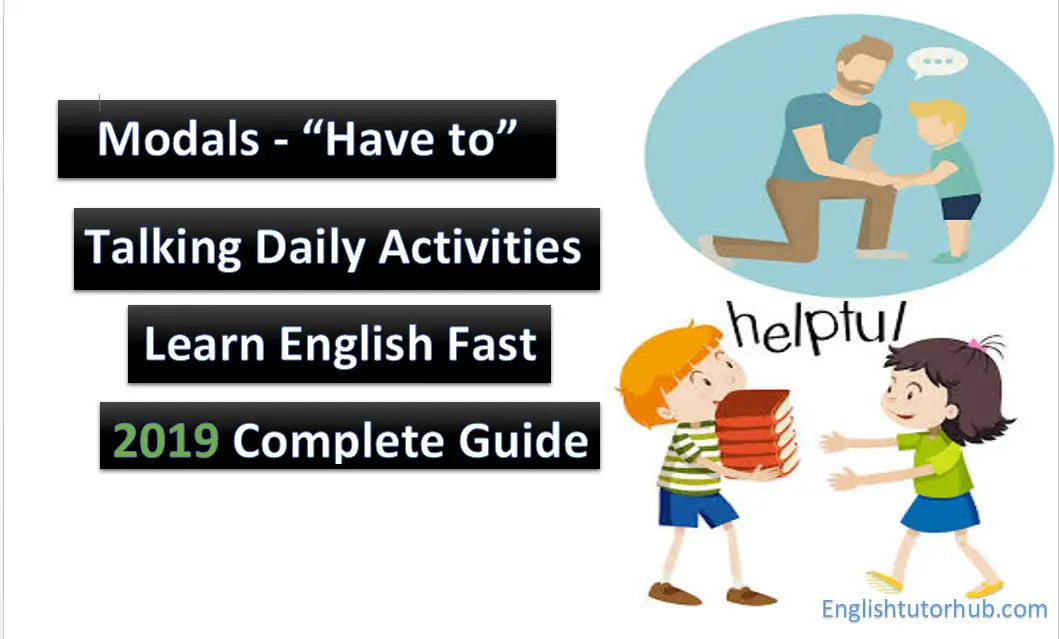Modals – Have to vs Has To Exercises- Talking Daily Activities
In this Tutorial you are going to learn English fast using Modals “Have to” vs “Has to” grammars- to talk daily activities tutorial performed by individuals on a daily basis necessary for independent living at home or in the community. This include feeding ourselves, bathing, dressing, grooming, going to work, homemaking, cleaning oneself and leisure. This is to perform and master the learning of modals “Have to” vs “Has to” exercises.
Target Grammar: Modals Have to VS Has to Exercise
Target Vocabulary: Daily activities (at home, at work, outside)
Materials: charts, picture
Value Focus: Be obedient/ Be Helpful
Drill of words: Daily activities
Do the laundry Wash the car
Go shopping Play with friends
Brush your hair Take pictures
Drive to work Go to school
Water the plant have breakfast
Show pictures of different daily activities and have the students give their thought on what they see and let them share their own daily activities.
PRESENTATION of Modals Have to VS Has to Grammar
- Listen to Aaron’s story and answer the questions that follow.
I have to give my boss a call and let him know that I will be late for work today. My car broke, so I have to find someone to fix it now. It will probably take a week, so I have to use the bus to go to work. I really hate it when I have to use the bus. I mean, it is not so bad, but why are there so many people on the bus? And why do they have to talk on the phone all the time?
- Read the statements and write T if the sentence is true and F if the sentence is false:
- Aaron has to give his boss a call and tell him he is late for school.
- Aaron’s car broke and now he has to use the bus.
- Aaron loves traveling by bus to work.
- Aaron wonders why people on the bus have to talk on the phone all the time.
Analysis / discussion
Discuss when and how to use “have to” if the sentence is positive
-
Positive
| I
You We They |
have to | infinitive verb | I have to go to work. |
| ItShe
He |
has to | infinitive verb | Aaron has to fix his car. |
-
Negative
| I You We They |
do not/ don’t
|
Have to
|
infinitive verb
|
I don’t have to go to work today.
|
| He She It |
does not/ doesn’t
|
have to |
infinitive verb
|
Aaron doesn’t have to fix his car. |
-
Positive questions
| Do | I You We They |
have to
|
infinitive verb
|
Do you have to go to work today?
|
| Does | He She It |
Have to |
infinitive verb
|
Does he have to fix his car? |
Generalization: “have to vs has to” Exercises
Ask: When do we use “have to/ has to”?
-We use have to and has to depending on the subject
– it is used to talk about something we must do,
because somebody told us or because it is a rule.
PRACTICE: Modals Have vs Has to Grammar
Make negative or positive sentences.
- I have to go to work in the morning.
- You don’t have to go shopping after work tomorrow.
- Sara has to do her homework today.
- David has to be home at 9 in the evening.
IV. Evaluation of “have to” and “has to” tutorial
Correct the mistakes in the sentences.
- I has to be there at 5 p.m.
- Monika don’t have to go to school tomorrow.
- Do he has to go the meeting?
- Does we have to bring our textbooks to school?
V. Homework
- Make a list of 10 things you have to do over the week.
Example: I have to do the washing on Sunday.
Practice have to VS has to exercises
A. Write “have to” or “has to” in the blanks to complete the sentence.
- They ____________ write a test.
- She ____________clean her desk.
- Ken and Liz ____________ learn English words.
- Andy ____________help his brother.
- We ____________do our homework.
- He ____________write with a pencil.
- I ____________feed the hamster.
- You ____________take photos.
- Victoria ____________ read the newspaper.
- The teacher ____________send a text message.
B. Fill in the space with “have to”, “has to” or “had to” to complete the blanks.
- Yesterday I ________ finish my geography project.
- She will ________ wait in line like everyone else.
- If you are under 13 you _____ get your parents’ permission.
- Your daughter may ________ try on a few different sizes.
- Do you _____ work next weekend?
Watch the Video Presentation of have to and has to tutorial Here.
You may visit this for the source.
For more readings
-
There is vs There are How to Choose? -Learn to Speak English Fast
-
Consonant Blends “fr” Words as in Frog With Sample Excercise
If you have any questions or suggestions about Modals – “Have to” – Talking Daily Activities, please feel free to leave a comment below or send us a message using our contact page.

